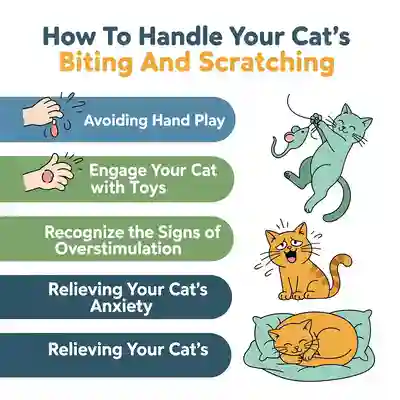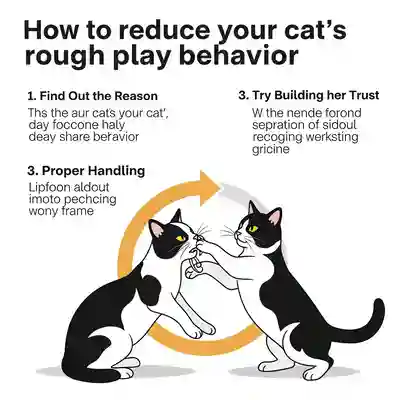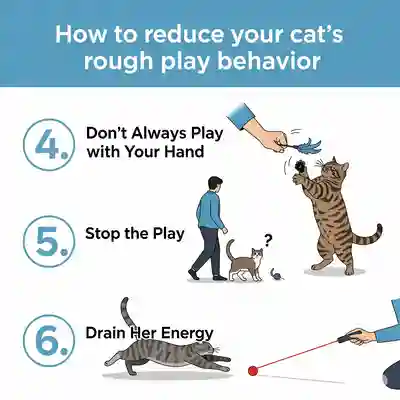Taming Your Cat's Biting and Scratching Behavior
From Claws to Calm: Navigating Your Cat's Biting and Scratching Habits
Are you tired of being bitten or scratched by your feline friend? You’re not alone. Many cat owners struggle with understanding why their cats exhibit aggressive behavior, leaving them confused and concerned.
Understanding cat behavior issues is the first step towards resolving them. Cats bite and scratch for various reasons, including fear, pain, or even playfulness. Recognizing the root cause of this behavior is crucial in managing feline aggressive behavior.
By delving into the world of understanding cat aggression, we can uncover the reasons behind these actions and find effective ways to address them. This article will explore the underlying causes of biting and scratching, providing insights into the feline mind and offering practical advice for a more harmonious coexistence with your cat.
Understanding and Managing Your Cat's Biting and Scratching Behavior
Understanding Why Your Cat Bites and Scratches
Cats bite and scratch for various reasons, and recognizing these reasons is key to dealing with aggressive pet cats effectively. Understanding the motivations behind your cat’s aggression is crucial for resolving the issue.
One of the primary reasons cats exhibit biting and scratching behavior is due to anxiety or stress. Cats may feel overwhelmed by their environment, leading to aggressive behavior. Techniques for cat behavior modification, such as providing a calm and safe space, can help alleviate this anxiety.
Another reason for this behavior is excess energy or play aggression. Cats, especially younger ones, may not know how to play gently and may bite or scratch during play. Preventing cat biting and scratching in such cases involves engaging your cat in appropriate play activities and teaching them gentle play.
Building trust with your cat is also essential in addressing biting and scratching behavior. By creating a positive and nurturing environment, you can help reduce your cat’s aggression. This involves being patient, moving slowly around your cat, and avoiding sudden gestures that might startle them.
By understanding the underlying causes of your cat’s behavior and applying appropriate techniques for cat behavior modification, you can significantly reduce biting and scratching incidents. This not only improves your relationship with your cat but also creates a safer and more enjoyable living environment for both you and your pet.

How To Handle Your Cat's Biting And Scratching!!
If your cat’s playful bites and scratches have become a concern, it’s time to learn effective ways to manage this behavior. Cats often exhibit biting and scratching due to overstimulation or excess energy.
Avoiding Hand Play
One of the most effective tips for managing cat aggression is to avoid using your hands as toys. When you use your hands to play with your cat, they may not differentiate between your hands as playthings or as something to be bitten or scratched during other interactions.
Instead, engage your cat with toys that can be batted around, such as feather wands or laser pointers. This not only saves your hands from potential scratches but also channels your cat’s energy into a more productive play.
It’s crucial to recognize the signs of overstimulation in your cat, such as tail flicking, ear flattening, or attempting to hide. When you notice these signs, it’s time to stop the play session. This is a vital cat aggression training tip that helps prevent your cat from becoming overstimulated and aggressive.
Additionally, ensuring your cat gets adequate exercise and mental stimulation can help reduce biting and scratching behavior. Engage your cat in play that drains their energy, and consider puzzle toys to challenge their minds.
Relieving your cat’s anxiety is also a key aspect of how to handle your cat’s biting and scratching. Sometimes, cats exhibit aggressive behavior due to stress or anxiety. Creating a calm environment, providing hiding spots, and maintaining a consistent routine can help alleviate your cat’s stress.

How to reduce your cat’s rough play behavior:
Cats display various types of behavior but two of them are their specific play behaviors: solitary play and social play. The first is directed towards their toys, paper boxes, etc and social play is towards fellow humans or other cats and animals.
The problems occur during the social play behaviors and during such plays, your cat can cause injury to the fellow human playmates. Those scratches and bites are very painful and can easily become infected.
1. Find Out the Reason
You should know how to pet your kitten first, try to know the reason for your cat’s aggressive behavior to address your cat’s biting. There could be millions of possibilities that she gets overzealous during play, maybe bored or frustrated, or she is asking you to stop doing something but you haven’t heard her. If you clear this first step then you can possibly stop your cats biting and scratchings.
2. With Proper Handling
Look for clear signs when your cat seeks your attention, don’t force her to stay near you. If you still wish to pet your kitty then, approach the side of your cat’s face with the back of your hand to pet, rather than going to the top of her head or his body as a safety measure.
3. Try Building her Trust
For a beautiful start look for a whipping tail, you must understand the kind of mindset your cat is in. Never force your cat to do something. They take time to settle down with you and let them do whatever they are doing. They try to analyze the environment they are in and check the place where they can adjust.
There are some signs that show the behavior of your cat and you can make contact with them. Like, after eating its food it comes to you and sits beside you. If the cat trusts you then she will less likely to bite you.
4. Don’t always Play with your Hand
If you always play with your cat with your hand, she might think it as a toy; instead, use a toy that keeps your hands at a safe distance from her mouth. Cats are like humans, they need to be active otherwise they will put a lot a weight which is not good for them. Exercise makes them physically and mentally fit.
You will see some changes in your cat and also it relieves their boredom and stress. A String Stick Toy is very simple and effective to start going with your cats.
5. Stop the Play
Abruptly call it a timeout, if you realize your cat goes after you during plays. If your cat bites during such occasions then turn your back immediately. Try not to speak with your kitty for a moment or resume the game, and your cat will realize this as a message after a few cycles of these.
Try not to shout at your cat, this gives a bad message in their mind. You must try to only appreciate them in their good behavior. Don’t go for eye contact, this is a way of challenging your cat in their language.
6. Drain her Energy
This is another way of getting your kitty back in a soft play. Try spending more time with her until you can see her tired. Go for a playtime session every day which will drain their energy and they will stop biting and scratching. They generally have a lot of energy and less work to drain it.
If your cat stops responding to you then you can bring your laser pointer and a fish or feather toy tied with the wand. These games will always keep her working even if she is tired.
7. Try Relieving her Anxiety
Your cat may transfer her anger and aggression to you even if they feel it towards something else, and these results in vicious and unprovoked attacks.
You can always use any calming products available in the market to make them relax from any situation they are having, but knowing the main cause and sorting this out can be a permanent solution.
8. Better Solution is Speaking to your Vet
Try taking our consultation, and our veterinarians are able to prescribe different food and medication to help calm your cat’s nerves after a proper examination and finding out the real cause for it.
Some brands with different foods have tryptophan which helps relax your cat. Somebody problems and diseases make cats grumpy and aggressive and during that no matter what you do, your cat will ever like you.


Conclusion
Taming your cat’s biting and scratching behavior requires patience, understanding, and the right techniques for cat behavior modification. By recognizing the reasons behind your cat’s aggression and applying appropriate strategies, you can significantly reduce unwanted behavior.
Managing feline aggressive behavior is a process that involves time and effort. If your cat continues to exhibit problematic behavior, it may be time to seek professional advice. A better solution is speaking to your vet, who can provide personalized guidance and help identify any underlying issues contributing to the aggression.
With the right approach and support, you can enjoy a more harmonious relationship with your feline companion. Don’t hesitate to reach out to a veterinary professional for help in addressing your cat’s biting and scratching.

The only thumb rule is to be patient! Good Luck!
FAQ
Why does my cat bite and scratch me?
How can I prevent my cat from biting and scratching?
What are some tips for managing my cat’s aggression?
How can I build trust with my aggressive cat?
When should I seek professional help for my cat’s aggression?
Can cat behavior modification techniques really help?
How can I identify the triggers of my cat’s aggression?


